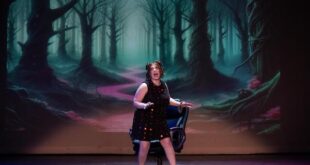Puccini intended his one-act opera Il Tabarro to be performed as part of a triptych. This week’s production from On Site Opera shows that it can well stand alone – or rock alone. For the adventurous company staged its invigorating production aboard and beside the historic lightship Ambrose, at South Street Seaport in lower Manhattan.
Il Tabarro may be a tale of doomed love and murder on a barge on the Seine, but in a production as colorful and kinetic as this one it can nonetheless elicit smiles of appreciation and amusement.
A Site to Behold
Whether inside a museum, as with their Murasaki’s Moon back in the Before Time, or outdoors at the edge of Manhattan where seagoing commerce once thrived, On Site Opera stages art normally seen in an opera house or concert hall in unconventional locales, with forethought and creativity. Directed by Laine Rettmer, their realization of Puccini’s one-act makes great use of the big red boat as both set and backdrop.

Giorgetta, wife of barge owner Michele, and gallant stevedore Luigi are in love – and very much in lust. The libretto speaks of some rather graphic lovemaking, in fact. This staging makes their passion convincing enough that one can understand why the production employed an intimacy director. Soprano Ashley Milanese and tenor Yi Li summon great charisma to match their sterling voices, while baritone Eric McKeever’s booming-voiced Michele is utterly convincing as he glowers and rages like an angry sea god. The rest of the cast sings beautifully too and matches them in thespian talent.

Musicians from the American Modern Ensemble form a small but energized orchestra conducted by Geoffrey McDonald. Their amplified efforts can sound a little tinny through the outdoor speakers, but one’s ears grow accustomed. Given the flat, windy space by the East River, one can’t be too finicky about the sound of a violin. And the amplification of the singers’ voices is truer, well modulated, no doubt the result of a good team effort by the talented cast and the sound crew.
Most of the action takes place on the intimate space of the dock. This makes the high and distant action on the boat itself – Michele’s emergences and disappearances, Luigi’s dashing up the stairs having mistaken Michele’s pipe for Giorgetta’s signal, and of course the horrid double murder – the more visually effective
The production’s boisterous, actually rather realistic depiction of the stevedores’ tough life is well played and commendable. Effective touches are many – minor characters who serve as symbols, an out-of-tune accordion, Talpa’s (Artega Wright) bad back, his wife La Frugola’s sack of scavenged goodies.

Giorgetta and Luigi’s duet about the village where they both grew up is the climax of the first half; Michele’s angry “Nulla! Silenzio!” caps the second. Both are compelling scenes, set amid a well-paced narrative full of smaller but equally well played scenes that flow swiftly by like a row of colorful sailboats. The costumes (by Howard Tsvi Kaplan) deck the characters in well-conceived period design, contributing significantly to the evocation of the milieu of old French salts.
Lost in the Music
Before I see any opera I find a synopsis to read, even if I’m relatively familiar with the work. With that, I easily followed the plot, which is straightforward for an opera. Lapses in the “supertitles” delivered via a phone app didn’t matter much; one gets tired of flicking one’s vision up and down anyway. At many moments I found myself lost in Puccini’s silky, many-colored, sometimes quirky music.
The recent Tosca from Heartbeat Opera reminded me how Puccini bridges some of the divides between the 19th and 20th centuries, shaking off stylistic constraints while remaining friendly to the ear, uplifting and continuously interesting. This Il Tabarro fully, even gleefully embodies the spirit of the music, just as the staging makes excellent creative use of the space.
The final performance is tonight (May 17), and the weather again looks glorious. Visit the On Site Opera website for information and tickets.
 Blogcritics The critical lens on today's culture & entertainment
Blogcritics The critical lens on today's culture & entertainment




